ATHC 1: Assessment Two - Nursing Assessment and Clinical Reasoning
VerifiedAdded on 2023/01/17
|7
|2128
|95
Homework Assignment
AI Summary
This assignment, ATHC 1 Assessment 2, focuses on nursing assessment and clinical reasoning. The student analyzes a patient scenario involving heavy bleeding, elevated vital signs (respiratory rate, heart rate, blood pressure, temperature, and oxygen saturation), and identifies potential nursing errors related to assessment techniques and documentation. The assignment includes a table defining vital signs, factors affecting them, normal ranges, and abnormal terminologies, supported by peer-reviewed references. The student reflects on the importance of assessments in the nursing process, the need for critical thinking, and the significance of avoiding medical errors. The student uses the clinical reasoning cycle to assess the patient's condition and identify potential errors in the nursing assessment. The student also provides a detailed analysis of the importance of assessments in the nursing process.
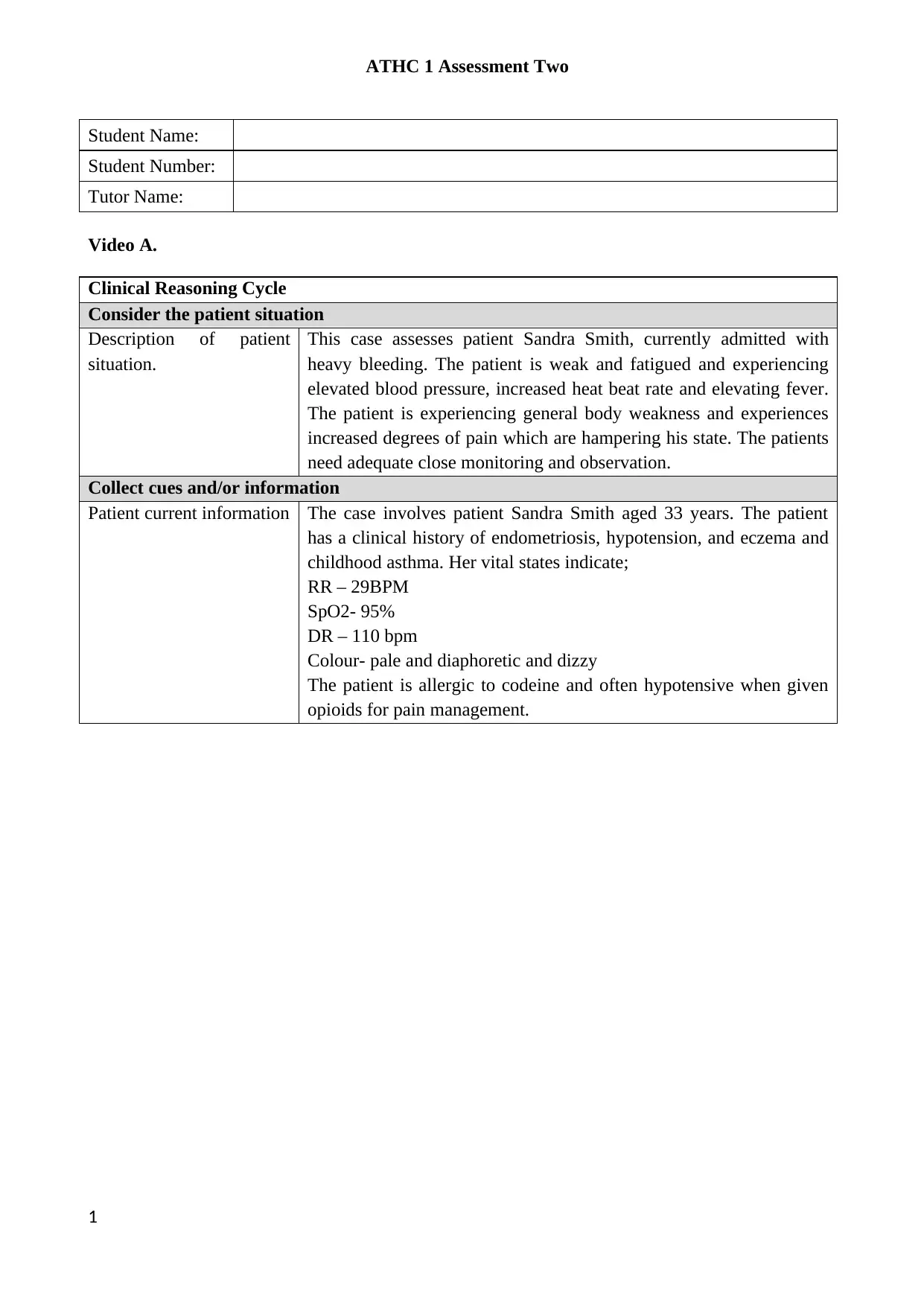
ATHC 1 Assessment Two
Student Name:
Student Number:
Tutor Name:
Video A.
Clinical Reasoning Cycle
Consider the patient situation
Description of patient
situation.
This case assesses patient Sandra Smith, currently admitted with
heavy bleeding. The patient is weak and fatigued and experiencing
elevated blood pressure, increased heat beat rate and elevating fever.
The patient is experiencing general body weakness and experiences
increased degrees of pain which are hampering his state. The patients
need adequate close monitoring and observation.
Collect cues and/or information
Patient current information The case involves patient Sandra Smith aged 33 years. The patient
has a clinical history of endometriosis, hypotension, and eczema and
childhood asthma. Her vital states indicate;
RR – 29BPM
SpO2- 95%
DR – 110 bpm
Colour- pale and diaphoretic and dizzy
The patient is allergic to codeine and often hypotensive when given
opioids for pain management.
1
Student Name:
Student Number:
Tutor Name:
Video A.
Clinical Reasoning Cycle
Consider the patient situation
Description of patient
situation.
This case assesses patient Sandra Smith, currently admitted with
heavy bleeding. The patient is weak and fatigued and experiencing
elevated blood pressure, increased heat beat rate and elevating fever.
The patient is experiencing general body weakness and experiences
increased degrees of pain which are hampering his state. The patients
need adequate close monitoring and observation.
Collect cues and/or information
Patient current information The case involves patient Sandra Smith aged 33 years. The patient
has a clinical history of endometriosis, hypotension, and eczema and
childhood asthma. Her vital states indicate;
RR – 29BPM
SpO2- 95%
DR – 110 bpm
Colour- pale and diaphoretic and dizzy
The patient is allergic to codeine and often hypotensive when given
opioids for pain management.
1
Paraphrase This Document
Need a fresh take? Get an instant paraphrase of this document with our AI Paraphraser
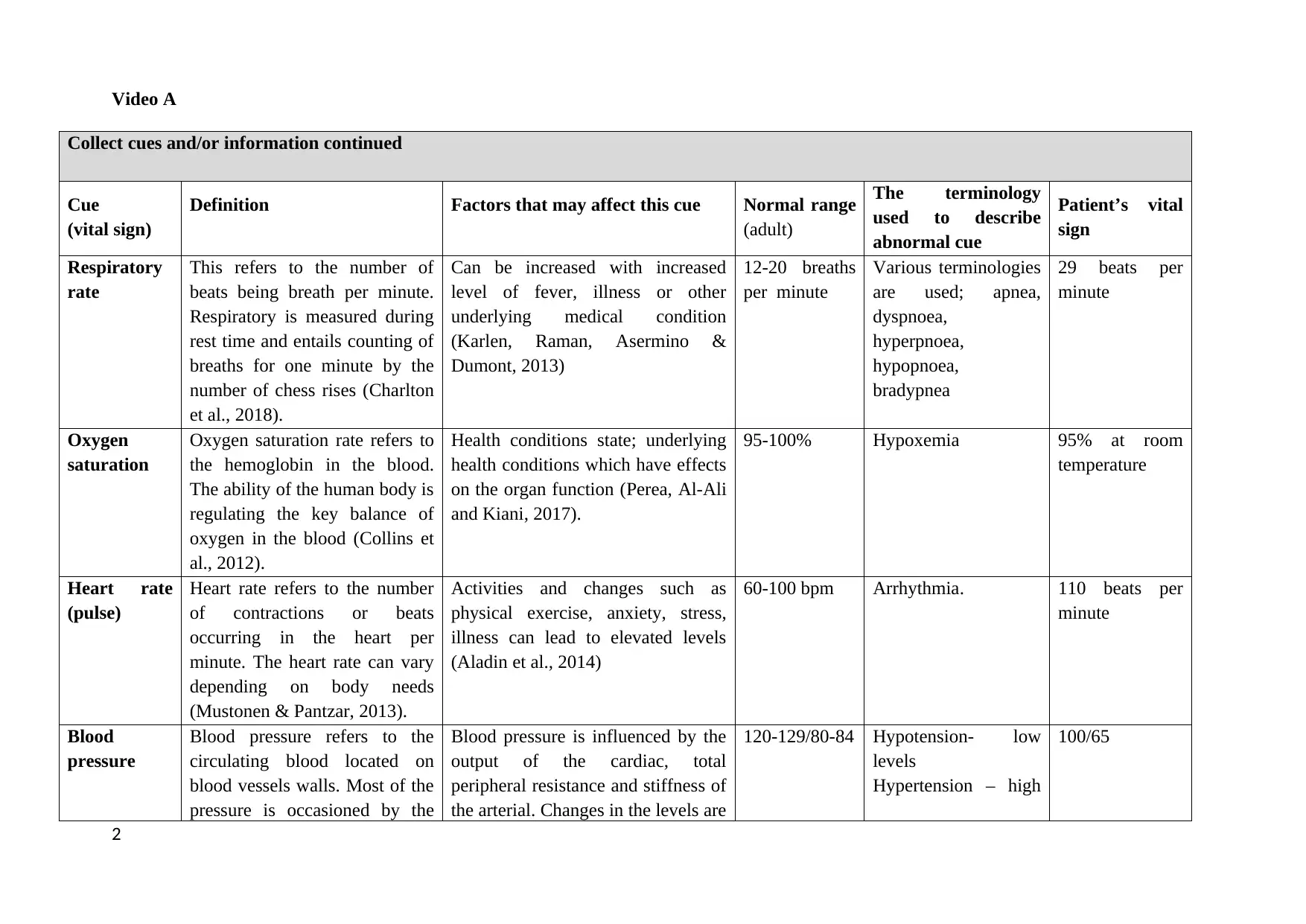
Video A
Collect cues and/or information continued
Cue
(vital sign)
Definition Factors that may affect this cue Normal range
(adult)
The terminology
used to describe
abnormal cue
Patient’s vital
sign
Respiratory
rate
This refers to the number of
beats being breath per minute.
Respiratory is measured during
rest time and entails counting of
breaths for one minute by the
number of chess rises (Charlton
et al., 2018).
Can be increased with increased
level of fever, illness or other
underlying medical condition
(Karlen, Raman, Asermino &
Dumont, 2013)
12-20 breaths
per minute
Various terminologies
are used; apnea,
dyspnoea,
hyperpnoea,
hypopnoea,
bradypnea
29 beats per
minute
Oxygen
saturation
Oxygen saturation rate refers to
the hemoglobin in the blood.
The ability of the human body is
regulating the key balance of
oxygen in the blood (Collins et
al., 2012).
Health conditions state; underlying
health conditions which have effects
on the organ function (Perea, Al-Ali
and Kiani, 2017).
95-100% Hypoxemia 95% at room
temperature
Heart rate
(pulse)
Heart rate refers to the number
of contractions or beats
occurring in the heart per
minute. The heart rate can vary
depending on body needs
(Mustonen & Pantzar, 2013).
Activities and changes such as
physical exercise, anxiety, stress,
illness can lead to elevated levels
(Aladin et al., 2014)
60-100 bpm Arrhythmia. 110 beats per
minute
Blood
pressure
Blood pressure refers to the
circulating blood located on
blood vessels walls. Most of the
pressure is occasioned by the
Blood pressure is influenced by the
output of the cardiac, total
peripheral resistance and stiffness of
the arterial. Changes in the levels are
120-129/80-84 Hypotension- low
levels
Hypertension – high
100/65
2
Collect cues and/or information continued
Cue
(vital sign)
Definition Factors that may affect this cue Normal range
(adult)
The terminology
used to describe
abnormal cue
Patient’s vital
sign
Respiratory
rate
This refers to the number of
beats being breath per minute.
Respiratory is measured during
rest time and entails counting of
breaths for one minute by the
number of chess rises (Charlton
et al., 2018).
Can be increased with increased
level of fever, illness or other
underlying medical condition
(Karlen, Raman, Asermino &
Dumont, 2013)
12-20 breaths
per minute
Various terminologies
are used; apnea,
dyspnoea,
hyperpnoea,
hypopnoea,
bradypnea
29 beats per
minute
Oxygen
saturation
Oxygen saturation rate refers to
the hemoglobin in the blood.
The ability of the human body is
regulating the key balance of
oxygen in the blood (Collins et
al., 2012).
Health conditions state; underlying
health conditions which have effects
on the organ function (Perea, Al-Ali
and Kiani, 2017).
95-100% Hypoxemia 95% at room
temperature
Heart rate
(pulse)
Heart rate refers to the number
of contractions or beats
occurring in the heart per
minute. The heart rate can vary
depending on body needs
(Mustonen & Pantzar, 2013).
Activities and changes such as
physical exercise, anxiety, stress,
illness can lead to elevated levels
(Aladin et al., 2014)
60-100 bpm Arrhythmia. 110 beats per
minute
Blood
pressure
Blood pressure refers to the
circulating blood located on
blood vessels walls. Most of the
pressure is occasioned by the
Blood pressure is influenced by the
output of the cardiac, total
peripheral resistance and stiffness of
the arterial. Changes in the levels are
120-129/80-84 Hypotension- low
levels
Hypertension – high
100/65
2
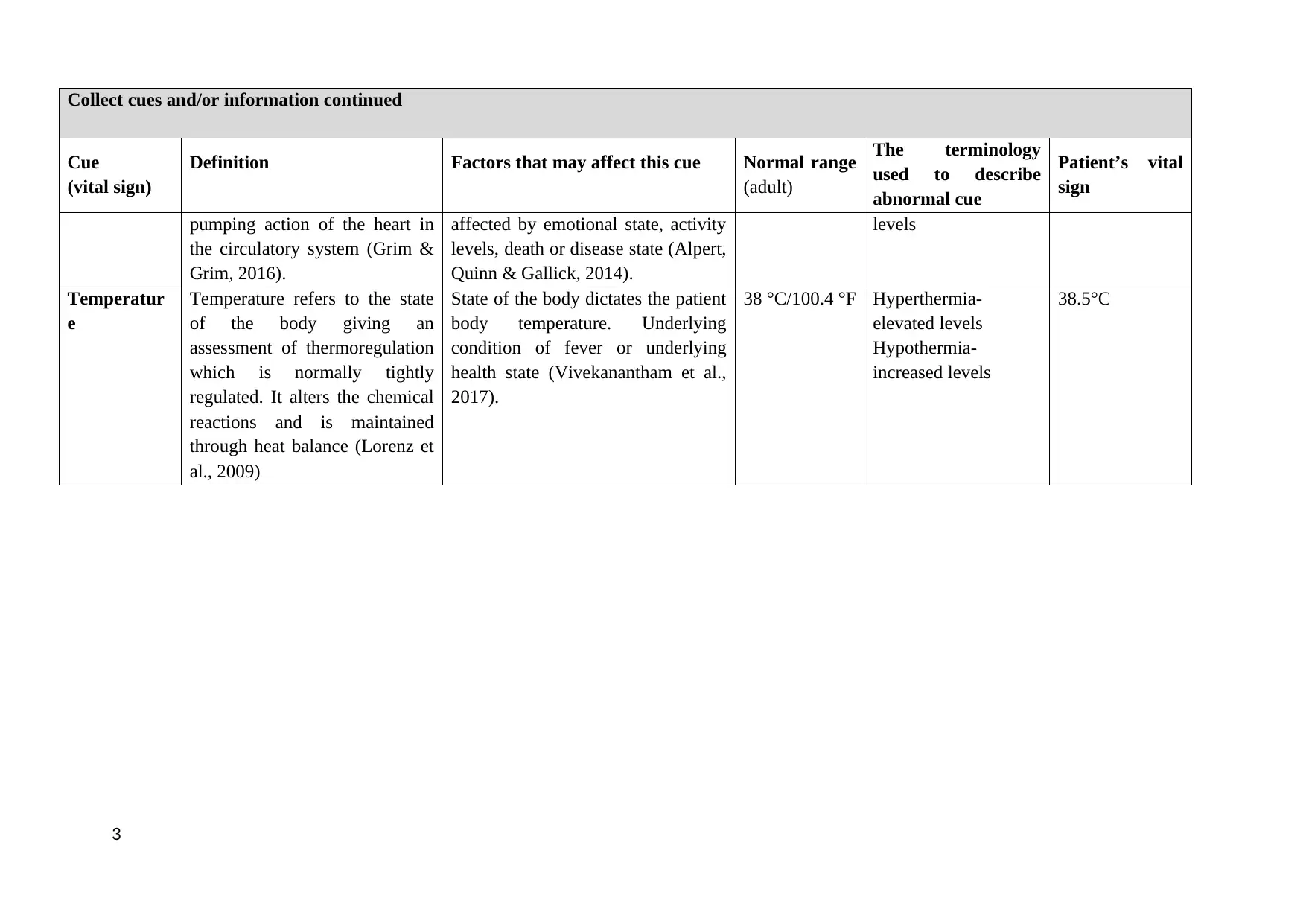
Collect cues and/or information continued
Cue
(vital sign)
Definition Factors that may affect this cue Normal range
(adult)
The terminology
used to describe
abnormal cue
Patient’s vital
sign
pumping action of the heart in
the circulatory system (Grim &
Grim, 2016).
affected by emotional state, activity
levels, death or disease state (Alpert,
Quinn & Gallick, 2014).
levels
Temperatur
e
Temperature refers to the state
of the body giving an
assessment of thermoregulation
which is normally tightly
regulated. It alters the chemical
reactions and is maintained
through heat balance (Lorenz et
al., 2009)
State of the body dictates the patient
body temperature. Underlying
condition of fever or underlying
health state (Vivekanantham et al.,
2017).
38 °C/100.4 °F Hyperthermia-
elevated levels
Hypothermia-
increased levels
38.5°C
3
Cue
(vital sign)
Definition Factors that may affect this cue Normal range
(adult)
The terminology
used to describe
abnormal cue
Patient’s vital
sign
pumping action of the heart in
the circulatory system (Grim &
Grim, 2016).
affected by emotional state, activity
levels, death or disease state (Alpert,
Quinn & Gallick, 2014).
levels
Temperatur
e
Temperature refers to the state
of the body giving an
assessment of thermoregulation
which is normally tightly
regulated. It alters the chemical
reactions and is maintained
through heat balance (Lorenz et
al., 2009)
State of the body dictates the patient
body temperature. Underlying
condition of fever or underlying
health state (Vivekanantham et al.,
2017).
38 °C/100.4 °F Hyperthermia-
elevated levels
Hypothermia-
increased levels
38.5°C
3
⊘ This is a preview!⊘
Do you want full access?
Subscribe today to unlock all pages.

Trusted by 1+ million students worldwide
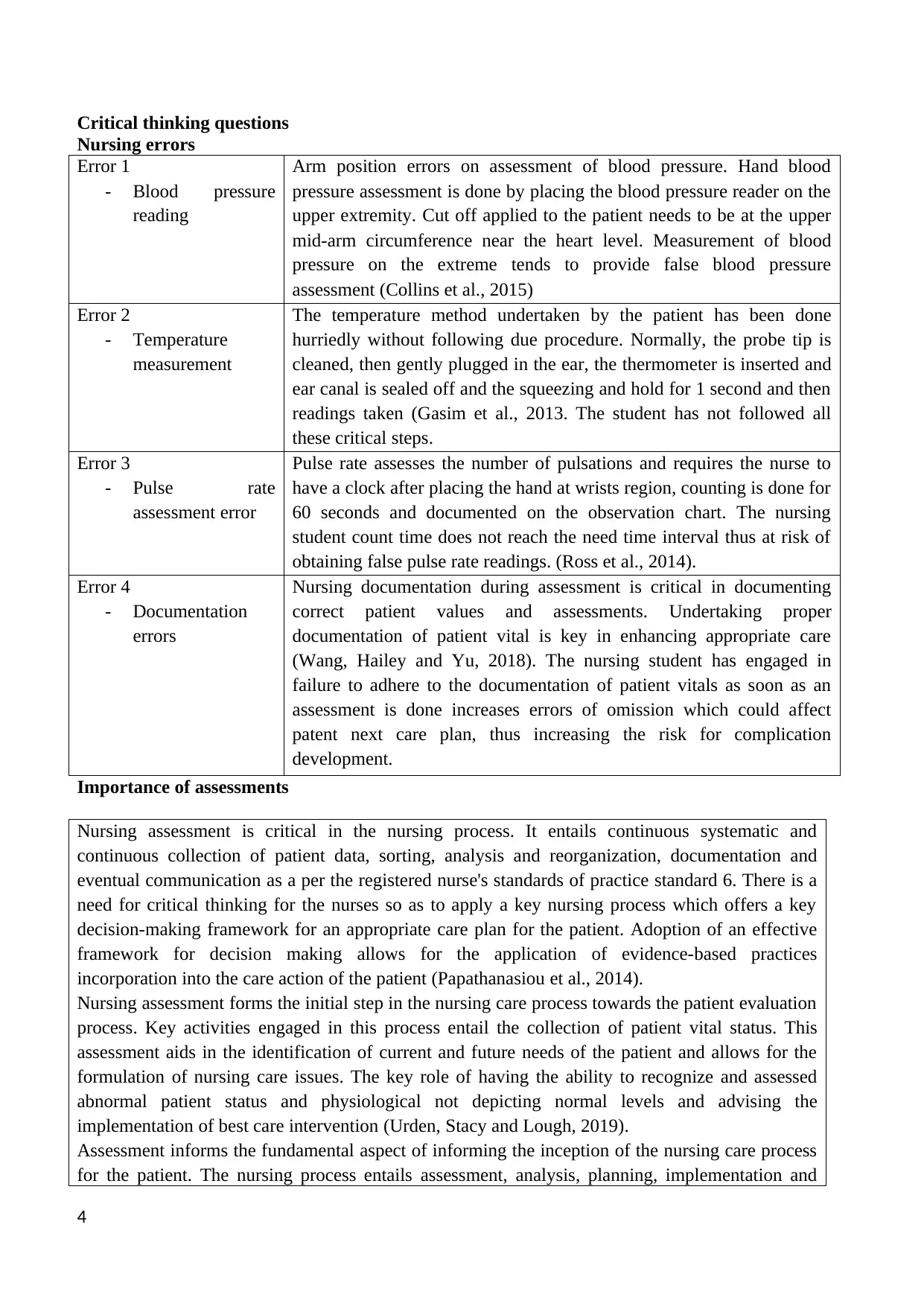
Critical thinking questions
Nursing errors
Error 1
- Blood pressure
reading
Arm position errors on assessment of blood pressure. Hand blood
pressure assessment is done by placing the blood pressure reader on the
upper extremity. Cut off applied to the patient needs to be at the upper
mid-arm circumference near the heart level. Measurement of blood
pressure on the extreme tends to provide false blood pressure
assessment (Collins et al., 2015)
Error 2
- Temperature
measurement
The temperature method undertaken by the patient has been done
hurriedly without following due procedure. Normally, the probe tip is
cleaned, then gently plugged in the ear, the thermometer is inserted and
ear canal is sealed off and the squeezing and hold for 1 second and then
readings taken (Gasim et al., 2013. The student has not followed all
these critical steps.
Error 3
- Pulse rate
assessment error
Pulse rate assesses the number of pulsations and requires the nurse to
have a clock after placing the hand at wrists region, counting is done for
60 seconds and documented on the observation chart. The nursing
student count time does not reach the need time interval thus at risk of
obtaining false pulse rate readings. (Ross et al., 2014).
Error 4
- Documentation
errors
Nursing documentation during assessment is critical in documenting
correct patient values and assessments. Undertaking proper
documentation of patient vital is key in enhancing appropriate care
(Wang, Hailey and Yu, 2018). The nursing student has engaged in
failure to adhere to the documentation of patient vitals as soon as an
assessment is done increases errors of omission which could affect
patent next care plan, thus increasing the risk for complication
development.
Importance of assessments
Nursing assessment is critical in the nursing process. It entails continuous systematic and
continuous collection of patient data, sorting, analysis and reorganization, documentation and
eventual communication as a per the registered nurse's standards of practice standard 6. There is a
need for critical thinking for the nurses so as to apply a key nursing process which offers a key
decision-making framework for an appropriate care plan for the patient. Adoption of an effective
framework for decision making allows for the application of evidence-based practices
incorporation into the care action of the patient (Papathanasiou et al., 2014).
Nursing assessment forms the initial step in the nursing care process towards the patient evaluation
process. Key activities engaged in this process entail the collection of patient vital status. This
assessment aids in the identification of current and future needs of the patient and allows for the
formulation of nursing care issues. The key role of having the ability to recognize and assessed
abnormal patient status and physiological not depicting normal levels and advising the
implementation of best care intervention (Urden, Stacy and Lough, 2019).
Assessment informs the fundamental aspect of informing the inception of the nursing care process
for the patient. The nursing process entails assessment, analysis, planning, implementation and
4
Nursing errors
Error 1
- Blood pressure
reading
Arm position errors on assessment of blood pressure. Hand blood
pressure assessment is done by placing the blood pressure reader on the
upper extremity. Cut off applied to the patient needs to be at the upper
mid-arm circumference near the heart level. Measurement of blood
pressure on the extreme tends to provide false blood pressure
assessment (Collins et al., 2015)
Error 2
- Temperature
measurement
The temperature method undertaken by the patient has been done
hurriedly without following due procedure. Normally, the probe tip is
cleaned, then gently plugged in the ear, the thermometer is inserted and
ear canal is sealed off and the squeezing and hold for 1 second and then
readings taken (Gasim et al., 2013. The student has not followed all
these critical steps.
Error 3
- Pulse rate
assessment error
Pulse rate assesses the number of pulsations and requires the nurse to
have a clock after placing the hand at wrists region, counting is done for
60 seconds and documented on the observation chart. The nursing
student count time does not reach the need time interval thus at risk of
obtaining false pulse rate readings. (Ross et al., 2014).
Error 4
- Documentation
errors
Nursing documentation during assessment is critical in documenting
correct patient values and assessments. Undertaking proper
documentation of patient vital is key in enhancing appropriate care
(Wang, Hailey and Yu, 2018). The nursing student has engaged in
failure to adhere to the documentation of patient vitals as soon as an
assessment is done increases errors of omission which could affect
patent next care plan, thus increasing the risk for complication
development.
Importance of assessments
Nursing assessment is critical in the nursing process. It entails continuous systematic and
continuous collection of patient data, sorting, analysis and reorganization, documentation and
eventual communication as a per the registered nurse's standards of practice standard 6. There is a
need for critical thinking for the nurses so as to apply a key nursing process which offers a key
decision-making framework for an appropriate care plan for the patient. Adoption of an effective
framework for decision making allows for the application of evidence-based practices
incorporation into the care action of the patient (Papathanasiou et al., 2014).
Nursing assessment forms the initial step in the nursing care process towards the patient evaluation
process. Key activities engaged in this process entail the collection of patient vital status. This
assessment aids in the identification of current and future needs of the patient and allows for the
formulation of nursing care issues. The key role of having the ability to recognize and assessed
abnormal patient status and physiological not depicting normal levels and advising the
implementation of best care intervention (Urden, Stacy and Lough, 2019).
Assessment informs the fundamental aspect of informing the inception of the nursing care process
for the patient. The nursing process entails assessment, analysis, planning, implementation and
4
Paraphrase This Document
Need a fresh take? Get an instant paraphrase of this document with our AI Paraphraser
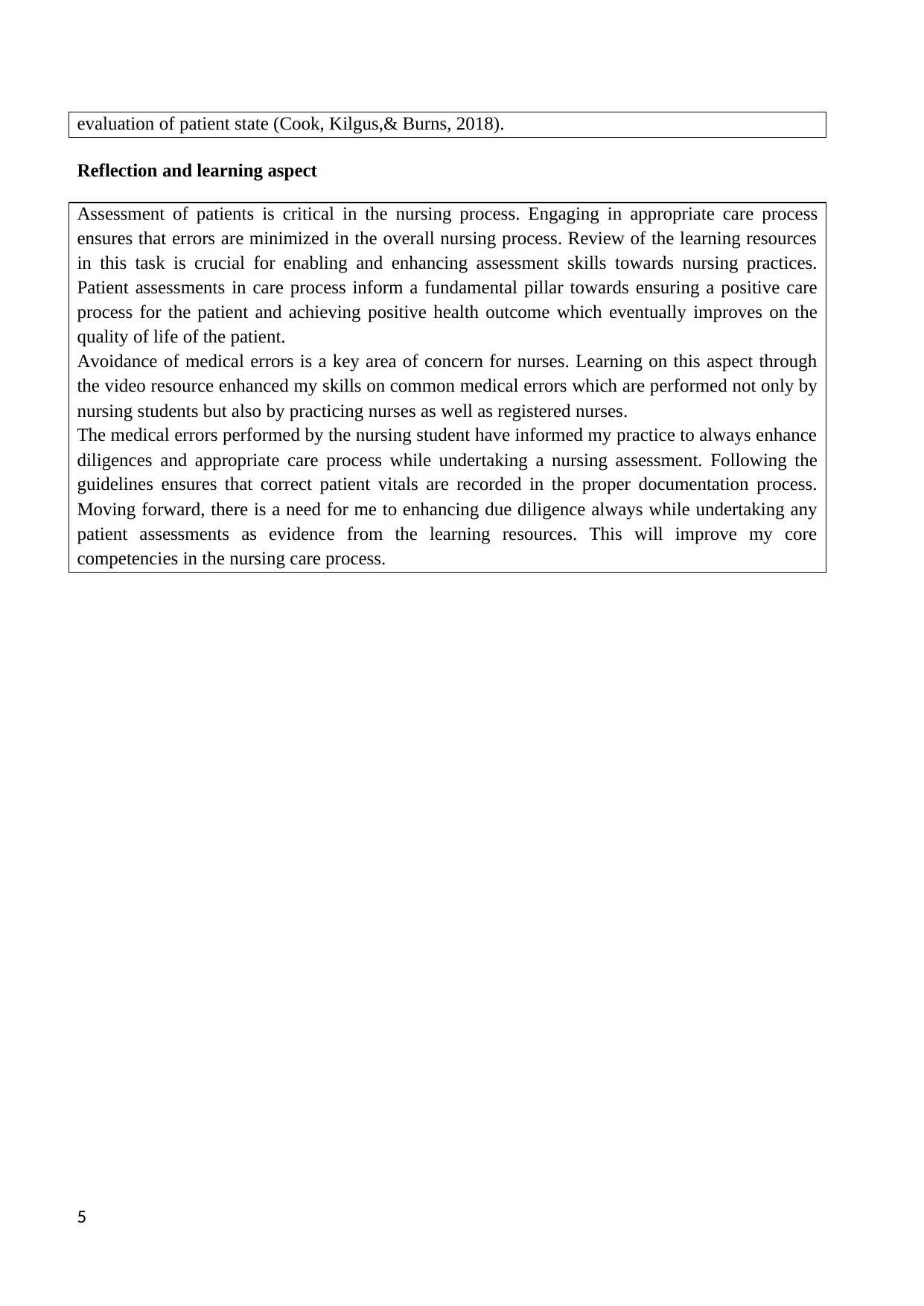
evaluation of patient state (Cook, Kilgus,& Burns, 2018).
Reflection and learning aspect
Assessment of patients is critical in the nursing process. Engaging in appropriate care process
ensures that errors are minimized in the overall nursing process. Review of the learning resources
in this task is crucial for enabling and enhancing assessment skills towards nursing practices.
Patient assessments in care process inform a fundamental pillar towards ensuring a positive care
process for the patient and achieving positive health outcome which eventually improves on the
quality of life of the patient.
Avoidance of medical errors is a key area of concern for nurses. Learning on this aspect through
the video resource enhanced my skills on common medical errors which are performed not only by
nursing students but also by practicing nurses as well as registered nurses.
The medical errors performed by the nursing student have informed my practice to always enhance
diligences and appropriate care process while undertaking a nursing assessment. Following the
guidelines ensures that correct patient vitals are recorded in the proper documentation process.
Moving forward, there is a need for me to enhancing due diligence always while undertaking any
patient assessments as evidence from the learning resources. This will improve my core
competencies in the nursing care process.
5
Reflection and learning aspect
Assessment of patients is critical in the nursing process. Engaging in appropriate care process
ensures that errors are minimized in the overall nursing process. Review of the learning resources
in this task is crucial for enabling and enhancing assessment skills towards nursing practices.
Patient assessments in care process inform a fundamental pillar towards ensuring a positive care
process for the patient and achieving positive health outcome which eventually improves on the
quality of life of the patient.
Avoidance of medical errors is a key area of concern for nurses. Learning on this aspect through
the video resource enhanced my skills on common medical errors which are performed not only by
nursing students but also by practicing nurses as well as registered nurses.
The medical errors performed by the nursing student have informed my practice to always enhance
diligences and appropriate care process while undertaking a nursing assessment. Following the
guidelines ensures that correct patient vitals are recorded in the proper documentation process.
Moving forward, there is a need for me to enhancing due diligence always while undertaking any
patient assessments as evidence from the learning resources. This will improve my core
competencies in the nursing care process.
5
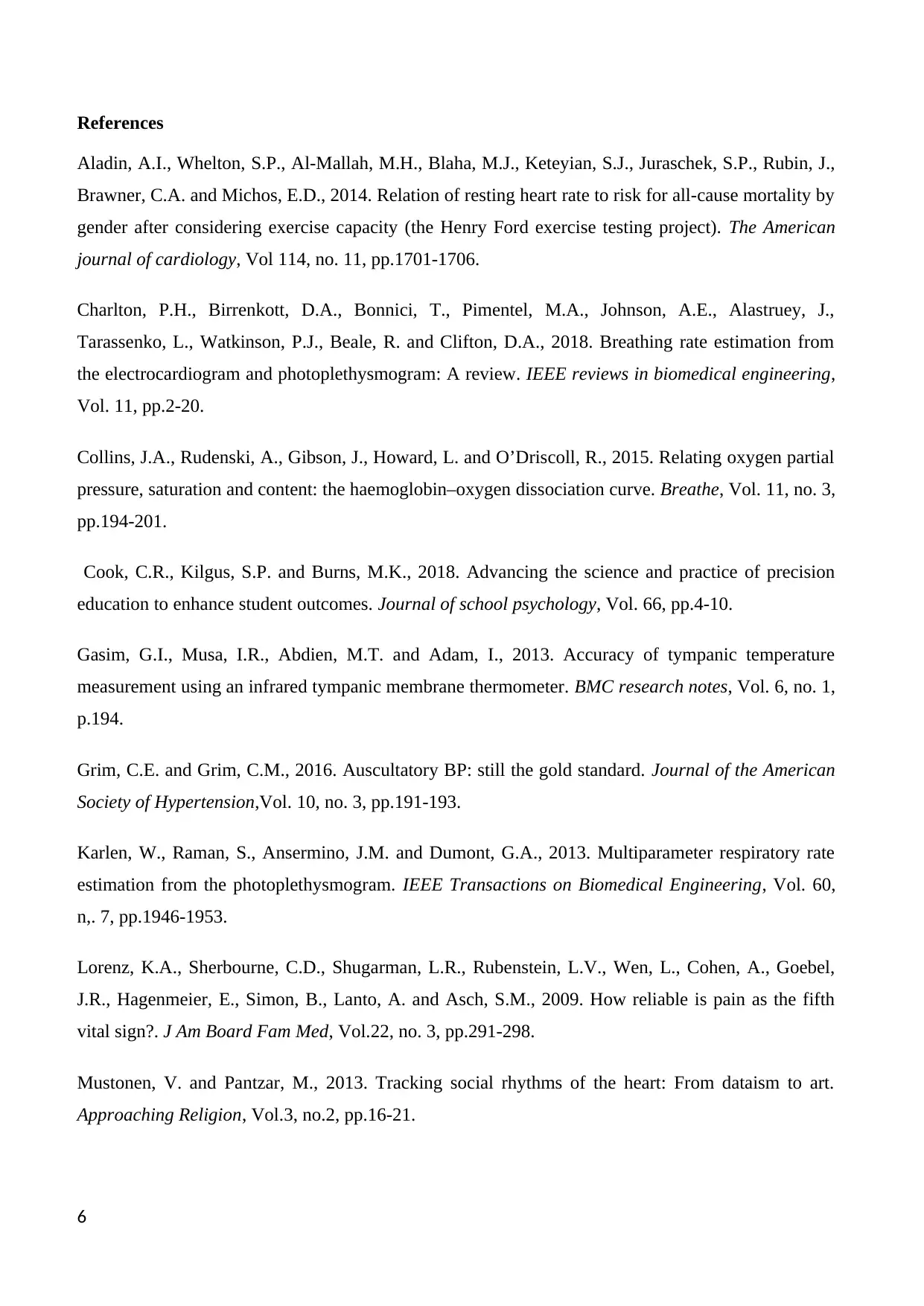
References
Aladin, A.I., Whelton, S.P., Al-Mallah, M.H., Blaha, M.J., Keteyian, S.J., Juraschek, S.P., Rubin, J.,
Brawner, C.A. and Michos, E.D., 2014. Relation of resting heart rate to risk for all-cause mortality by
gender after considering exercise capacity (the Henry Ford exercise testing project). The American
journal of cardiology, Vol 114, no. 11, pp.1701-1706.
Charlton, P.H., Birrenkott, D.A., Bonnici, T., Pimentel, M.A., Johnson, A.E., Alastruey, J.,
Tarassenko, L., Watkinson, P.J., Beale, R. and Clifton, D.A., 2018. Breathing rate estimation from
the electrocardiogram and photoplethysmogram: A review. IEEE reviews in biomedical engineering,
Vol. 11, pp.2-20.
Collins, J.A., Rudenski, A., Gibson, J., Howard, L. and O’Driscoll, R., 2015. Relating oxygen partial
pressure, saturation and content: the haemoglobin–oxygen dissociation curve. Breathe, Vol. 11, no. 3,
pp.194-201.
Cook, C.R., Kilgus, S.P. and Burns, M.K., 2018. Advancing the science and practice of precision
education to enhance student outcomes. Journal of school psychology, Vol. 66, pp.4-10.
Gasim, G.I., Musa, I.R., Abdien, M.T. and Adam, I., 2013. Accuracy of tympanic temperature
measurement using an infrared tympanic membrane thermometer. BMC research notes, Vol. 6, no. 1,
p.194.
Grim, C.E. and Grim, C.M., 2016. Auscultatory BP: still the gold standard. Journal of the American
Society of Hypertension,Vol. 10, no. 3, pp.191-193.
Karlen, W., Raman, S., Ansermino, J.M. and Dumont, G.A., 2013. Multiparameter respiratory rate
estimation from the photoplethysmogram. IEEE Transactions on Biomedical Engineering, Vol. 60,
n,. 7, pp.1946-1953.
Lorenz, K.A., Sherbourne, C.D., Shugarman, L.R., Rubenstein, L.V., Wen, L., Cohen, A., Goebel,
J.R., Hagenmeier, E., Simon, B., Lanto, A. and Asch, S.M., 2009. How reliable is pain as the fifth
vital sign?. J Am Board Fam Med, Vol.22, no. 3, pp.291-298.
Mustonen, V. and Pantzar, M., 2013. Tracking social rhythms of the heart: From dataism to art.
Approaching Religion, Vol.3, no.2, pp.16-21.
6
Aladin, A.I., Whelton, S.P., Al-Mallah, M.H., Blaha, M.J., Keteyian, S.J., Juraschek, S.P., Rubin, J.,
Brawner, C.A. and Michos, E.D., 2014. Relation of resting heart rate to risk for all-cause mortality by
gender after considering exercise capacity (the Henry Ford exercise testing project). The American
journal of cardiology, Vol 114, no. 11, pp.1701-1706.
Charlton, P.H., Birrenkott, D.A., Bonnici, T., Pimentel, M.A., Johnson, A.E., Alastruey, J.,
Tarassenko, L., Watkinson, P.J., Beale, R. and Clifton, D.A., 2018. Breathing rate estimation from
the electrocardiogram and photoplethysmogram: A review. IEEE reviews in biomedical engineering,
Vol. 11, pp.2-20.
Collins, J.A., Rudenski, A., Gibson, J., Howard, L. and O’Driscoll, R., 2015. Relating oxygen partial
pressure, saturation and content: the haemoglobin–oxygen dissociation curve. Breathe, Vol. 11, no. 3,
pp.194-201.
Cook, C.R., Kilgus, S.P. and Burns, M.K., 2018. Advancing the science and practice of precision
education to enhance student outcomes. Journal of school psychology, Vol. 66, pp.4-10.
Gasim, G.I., Musa, I.R., Abdien, M.T. and Adam, I., 2013. Accuracy of tympanic temperature
measurement using an infrared tympanic membrane thermometer. BMC research notes, Vol. 6, no. 1,
p.194.
Grim, C.E. and Grim, C.M., 2016. Auscultatory BP: still the gold standard. Journal of the American
Society of Hypertension,Vol. 10, no. 3, pp.191-193.
Karlen, W., Raman, S., Ansermino, J.M. and Dumont, G.A., 2013. Multiparameter respiratory rate
estimation from the photoplethysmogram. IEEE Transactions on Biomedical Engineering, Vol. 60,
n,. 7, pp.1946-1953.
Lorenz, K.A., Sherbourne, C.D., Shugarman, L.R., Rubenstein, L.V., Wen, L., Cohen, A., Goebel,
J.R., Hagenmeier, E., Simon, B., Lanto, A. and Asch, S.M., 2009. How reliable is pain as the fifth
vital sign?. J Am Board Fam Med, Vol.22, no. 3, pp.291-298.
Mustonen, V. and Pantzar, M., 2013. Tracking social rhythms of the heart: From dataism to art.
Approaching Religion, Vol.3, no.2, pp.16-21.
6
⊘ This is a preview!⊘
Do you want full access?
Subscribe today to unlock all pages.

Trusted by 1+ million students worldwide
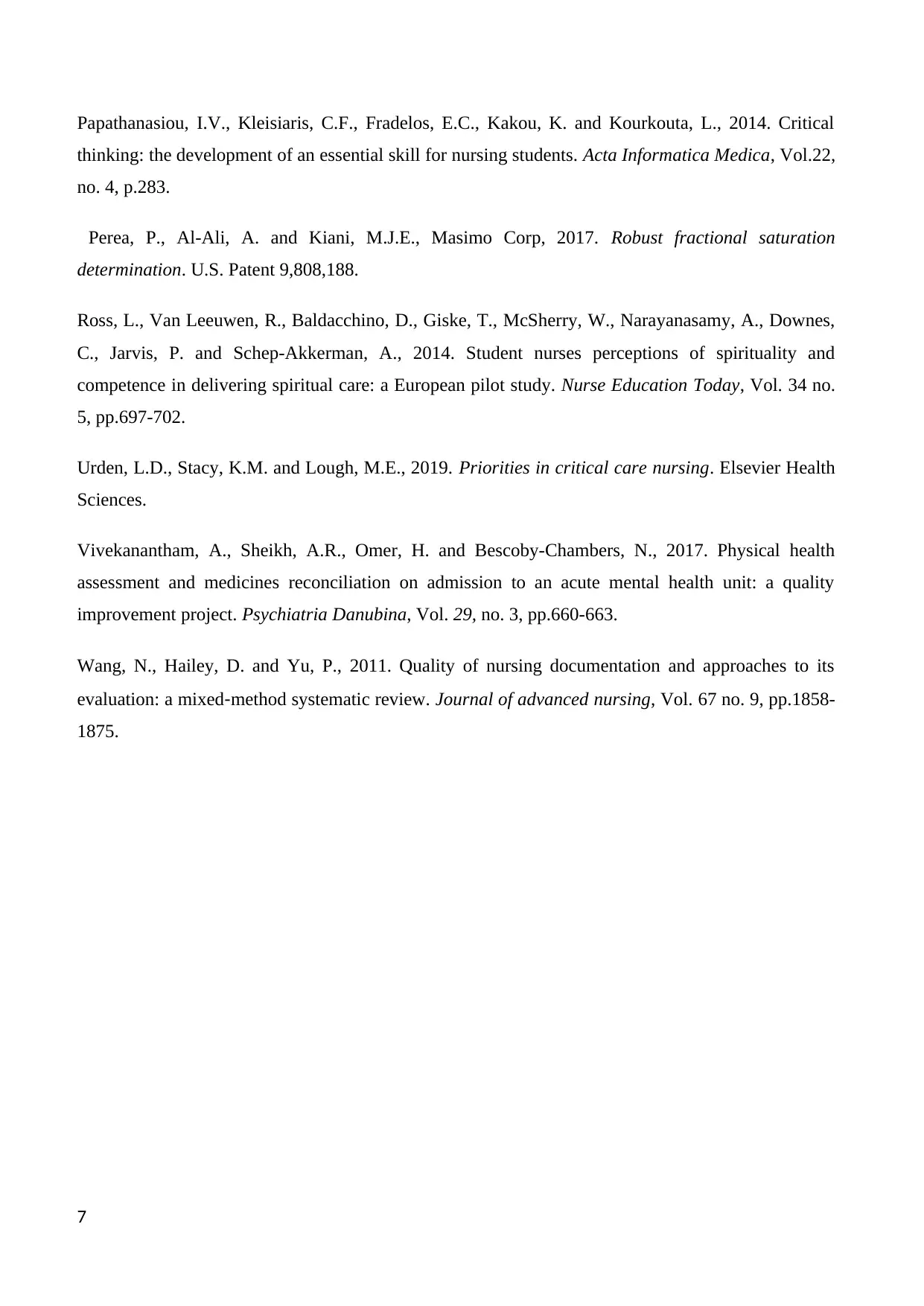
Papathanasiou, I.V., Kleisiaris, C.F., Fradelos, E.C., Kakou, K. and Kourkouta, L., 2014. Critical
thinking: the development of an essential skill for nursing students. Acta Informatica Medica, Vol.22,
no. 4, p.283.
Perea, P., Al-Ali, A. and Kiani, M.J.E., Masimo Corp, 2017. Robust fractional saturation
determination. U.S. Patent 9,808,188.
Ross, L., Van Leeuwen, R., Baldacchino, D., Giske, T., McSherry, W., Narayanasamy, A., Downes,
C., Jarvis, P. and Schep-Akkerman, A., 2014. Student nurses perceptions of spirituality and
competence in delivering spiritual care: a European pilot study. Nurse Education Today, Vol. 34 no.
5, pp.697-702.
Urden, L.D., Stacy, K.M. and Lough, M.E., 2019. Priorities in critical care nursing. Elsevier Health
Sciences.
Vivekanantham, A., Sheikh, A.R., Omer, H. and Bescoby-Chambers, N., 2017. Physical health
assessment and medicines reconciliation on admission to an acute mental health unit: a quality
improvement project. Psychiatria Danubina, Vol. 29, no. 3, pp.660-663.
Wang, N., Hailey, D. and Yu, P., 2011. Quality of nursing documentation and approaches to its
evaluation: a mixed‐method systematic review. Journal of advanced nursing, Vol. 67 no. 9, pp.1858-
1875.
7
thinking: the development of an essential skill for nursing students. Acta Informatica Medica, Vol.22,
no. 4, p.283.
Perea, P., Al-Ali, A. and Kiani, M.J.E., Masimo Corp, 2017. Robust fractional saturation
determination. U.S. Patent 9,808,188.
Ross, L., Van Leeuwen, R., Baldacchino, D., Giske, T., McSherry, W., Narayanasamy, A., Downes,
C., Jarvis, P. and Schep-Akkerman, A., 2014. Student nurses perceptions of spirituality and
competence in delivering spiritual care: a European pilot study. Nurse Education Today, Vol. 34 no.
5, pp.697-702.
Urden, L.D., Stacy, K.M. and Lough, M.E., 2019. Priorities in critical care nursing. Elsevier Health
Sciences.
Vivekanantham, A., Sheikh, A.R., Omer, H. and Bescoby-Chambers, N., 2017. Physical health
assessment and medicines reconciliation on admission to an acute mental health unit: a quality
improvement project. Psychiatria Danubina, Vol. 29, no. 3, pp.660-663.
Wang, N., Hailey, D. and Yu, P., 2011. Quality of nursing documentation and approaches to its
evaluation: a mixed‐method systematic review. Journal of advanced nursing, Vol. 67 no. 9, pp.1858-
1875.
7
1 out of 7
Related Documents
Your All-in-One AI-Powered Toolkit for Academic Success.
+13062052269
info@desklib.com
Available 24*7 on WhatsApp / Email
![[object Object]](/_next/static/media/star-bottom.7253800d.svg)
Unlock your academic potential
Copyright © 2020–2025 A2Z Services. All Rights Reserved. Developed and managed by ZUCOL.





